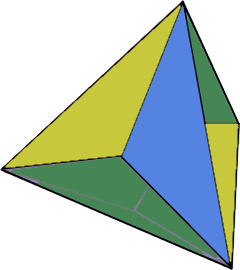Triakis Tetrahedron Calculator
Calculator and formulas for calculating a triakis tetrahedron
Triakis Tetrahedron Calculator
The Triakis Tetrahedron
A Triakis Tetrahedron is a Catalan solid with 12 isosceles triangular faces - dual to the truncated tetrahedron.
Triakis Tetrahedron Properties
The Tetrahedral Triangle Master: Dual to the truncated tetrahedron
Triakis Tetrahedron Structure

The tetrahedral triangle master with 12 faces.
Dual to the truncated tetrahedron.
|
|
What is a Triakis Tetrahedron?
A Triakis Tetrahedron is the simplest Catalan solid:
- Definition: Polyhedron with 12 isosceles triangular faces
- Faces: Each face is an isosceles triangle with two different edge types
- Dual: To the truncated tetrahedron
- Vertices: 8 vertices with different coordination
- Edges: 18 edges in two different lengths
- Symmetry: Tetrahedral symmetry group
Geometric Properties of the Triakis Tetrahedron
The Triakis Tetrahedron exhibits beautiful tetrahedral geometric properties:
Basic Parameters
- Edge Types: Tetrahedron edges (a) and pyramid edges (b)
- Faces: 12 congruent isosceles triangles
- Euler Characteristic: V - E + F = 8 - 18 + 12 = 2
- Dual Form: Truncated tetrahedron
Tetrahedral Properties
- Catalan Solid: Dual to Archimedean solid
- Triangular Faces: Each face is an isosceles triangle
- Simple Ratios: Proportions with √2, √3, √6
- Tetrahedral Symmetry: 24 symmetry operations
Mathematical Relationships
The Triakis Tetrahedron follows elegant mathematical laws:
Volume Formula
Simple formula with √2. Coefficient = 3√2/20.
Surface Area Formula
Sum of 12 isosceles triangles. Formula with √11.
Applications of the Triakis Tetrahedron
Triakis Tetrahedra find applications in tetrahedral studies:
Scientific Research
- Tetrahedral crystallography
- Crystal structure analysis
- Simple ratio studies
- Mathematical symmetry
Engineering
- Tetrahedral structures
- Simple geometric design
- Basic optimization
- Mathematical modeling
Education
- Basic Catalan solid education
- Tetrahedral symmetry studies
- Introduction to geometry
- Mathematical demonstrations
Art & Design
- Tetrahedral sculptures
- Simple art installations
- Mathematical decorations
- Basic pattern design
Formulas for the Triakis Tetrahedron
Pyramid Edge (b)
Simple pyramid edge relationship
Height (h)
Height with √6 factor
Surface Area (A)
Surface area with √11
Volume (V)
Volume with √2 coefficient
Circumradius (RK)
Circumradius with √2
Inradius (RI)
Inradius with √2/√11
Isosceles Triangle Properties
All isosceles and congruent
Tetrahedron (a) and pyramid (b) edges
All proportions with √2, √3, √6
Each triangle has one tetrahedron edge (a) and two pyramid edges (b = 3a/5)
Calculation Example for a Triakis Tetrahedron
Given
Find: All properties of the tetrahedral triangle master
1. Surface Area Calculation
The surface area is 198 square units
2. Volume Calculation
The volume is 212 cubic units
3. Pyramid Edge and Height
Pyramid edge: 6.0, Height: 14.7 units
4. Radii
Circumradius: 3.54, Inradius: 3.21 units
5. The Tetrahedral Triangle Master
The tetrahedral triangle master with perfect simple symmetry
The Triakis Tetrahedron: The Tetrahedral Triangle Master
The Triakis Tetrahedron stands as the simplest and most elegant among the Catalan solids, representing the perfect introduction to the world of dual polyhedra and tetrahedral symmetry. With its 12 congruent isosceles triangular faces, each having two different edge lengths in simple rational proportions, it demonstrates how basic mathematical relationships can organize three-dimensional space into forms of extraordinary geometric harmony. As the dual to the truncated tetrahedron, it transforms the mixed face arrangements of its Archimedean partner into a uniform pattern of triangular faces, creating a polyhedron that serves as both an educational masterpiece and a natural expression of tetrahedral perfection.
The Tetrahedral Foundation
The Triakis Tetrahedron showcases tetrahedral mathematics in its purest form:
- 12 Isosceles Triangles: Each face has one tetrahedron edge and two pyramid edges
- Tetrahedral Symmetry: 24 symmetry operations of the simplest three-dimensional group
- Simple Proportions: All relationships involve basic ratios and square roots
- Edge Diversity: Two different edge lengths in 5:3 ratio
- Elegant Mathematics: Beautiful formulas with √2, √3, √6, √11
- Platonic Heritage: Directly related to the tetrahedron
- Educational Perfect: Ideal for learning Catalan solid principles
Catalan Heritage and Tetrahedral Duality
Catalan Simplicity
As the simplest Catalan solid, the Triakis Tetrahedron perfectly demonstrates the principle of duality with the truncated tetrahedron, showing how mixed face arrangements become uniform triangular patterns.
Tetrahedral Duality
The duality with the truncated tetrahedron creates a beautiful relationship where the complex face types (triangles and hexagons) of the dual become uniform isosceles triangles with consistent proportions.
Triangular Perfection
With 12 faces arranged in perfect tetrahedral symmetry, each triangle maintains simple edge relationships, creating a form where mathematical elegance and geometric beauty converge.
Mathematical Beauty
The formulas demonstrate the elegant way simple mathematics can describe three-dimensional forms, with square roots appearing naturally in all calculations and edge relationships.
Summary
The Triakis Tetrahedron stands as a perfect example of how simple mathematical relationships and tetrahedral symmetry can combine to create forms of extraordinary elegance and educational value. Its 12 isosceles triangular faces, each with edges in simple proportions and arranged in perfect tetrahedral symmetry, make it both an ideal introduction to Catalan solids and a mathematical gem. From its role in educational demonstrations to its applications in basic symmetry studies, it shows how mathematical beauty can emerge from the simplest relationships. As a bridge between elementary geometry and advanced polyhedron theory, the Triakis Tetrahedron continues to inspire students, educators, and anyone beginning their journey into the fascinating world of three-dimensional mathematical forms.